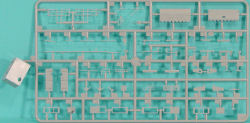
Trumpeter 1/144 Landing Craft Air Cushion (LCAC) Kit First Look
By Michael Benolkin
| Date of Review | August 2007 | Manufacturer | Trumpeter |
|---|---|---|---|
| Subject | Landing Craft Air Cushion (LCAC) | Scale | 1/144 |
| Kit Number | 0107 | Primary Media | Styrene, Rubber Skirt, Photo-Etch |
| Pros | Very nice detailing | Cons | |
| Skill Level | Intermediate | MSRP (USD) | $35.95 |
First Look
 |
 |
 |
 |
 |
 |
 |
During World War Two, US and allied forces relied on the landing craft to make the transition from ship to shore in the least amount of time with the least amount of vulnerability. The problem then was that these early landing craft couldn't always reach the beaches and would have to drop troops and vehicles in the water. Their slow speeds also made them vulnerable to shore batteries and machine gun nests.
Decades later, technology has provided a unique solution, the LCAC - Landing Craft Air Cushion. An LCAC can lift the heaviest battle tanks and 'fly' them ashore. There isn't an issue with reefs, marshes, or swamps, the LCAC can float over all of them and take troops and equipment to the hard ground, unload, then fly back to the amphibious asssault ship for the next load.
The LCAC can loft a 60 ton payload at 40 knots, all riding atop an air cushion that is contained with a rubber skirt that has little or no draft.
Here is a subject that has been long overlooked in the hobby industry, and Trumpeter has really pulled out the stops on this. In 1/144 scale, the kit isn't huge, but it does give you an idea of the size of this craft in real life. The kit is molded in the usual light gray styrene and presented on five parts trees, plus the main deck and underside as separate parts. The kit also includes a single tree of clear parts, a fret of photo-etch for the numerous air ducts and vents, and that signature rubber skirt that allows the LCAC to float upon a bubble of air.
The kit starts by combining the upper and lower deck plates and adding the frames for the fore and aft loading ramps. These ramps are then assembled and installed in the closed position. The way that the rubber skirt is molded is in the 'flight' shape, so there isn't much point in lowering these ramps.
The next set of assemblies are the various deck houses that contain the gas turbines that provide the lift as well as drive the main propellers/thrusters. Each of these are very nicely detailed. Of course one of these deck houses is also the pilot house/cockpit for this craft. As you might expect in this scale, this isn't an overly complex kit, but with all of the photo-etch grillwork, this is still best left to an experienced modeler working with small photo-etched parts.
The kit also incudes a good-sized sheet of decals to provide all of the various safety and identification markings on the craft. Options are provided to represent LCAC-43 or LCAC-57.
I'm impressed! While I'll leave it to the amphib experts to comment on specific aspects of its accuracy, from where I sit, this kit looks like a very nice piece of work.
My sincere thanks to Stevens International for this review sample!







